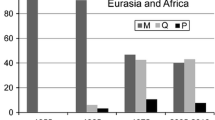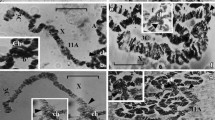Abstract
In the absence of meiotic recombination, deleterious mutations, decreasing the viability, are accumulated and fixed in small Drosophila populations. Study of the viability of hybrid progenies of three laboratory Drosophila melanogaster strains carrying meiotic mutation c(3)G 17 has suggested that the deleterious mutations are negatively synergistic in their interaction. The deleterious mutations localized to the pericentromeric region of chromosome 3 are threefold more efficient as compared with the mutations located in distal regions. Substitution of a new chromosome for the balancer chromosome in a strain with meiotic mutation c(3)G 17 partially restores (by ∼20%) the viability of homozygotes c(3)G 17/c(3)G 17 over the first 20–30 generations. Further cultivation for 30 generations with the same balancer again decreases the viability to the initial level. An epigenetic nature of deleterious mutations is discussed.
Similar content being viewed by others
References
Timofeeff-Ressovsky, N.W., Experimental Production of Mutations, Biol. Rev., 1934, vol. 9, no. 4, pp. 411–457.
Kondrashov, A.S., Deleterious Mutations and Evolution of Sexual Reproduction, Nature, 1988, vol. 336, pp. 435–440.
Kondrashov, A.S., Classification of Hypothesis on the Advantage of Amphimixis, J. Hered., 1993, vol. 84, pp. 372–387.
Kondrashov, A.S., The Asexual Ploidy Cycle and the Origin of Sex, Nature, 1994, vol. 370, pp. 213–216.
Li, E., Chromatin Modification and Epigenetic Reprogrammingin Mammalian Development, Nature Rev., 2002, vol. 3, pp. 662–673.
Chubykin, V.L., Survival of Drosorhila melanogaster Progeny after Prolonged Suppression of Pairing and Recombination in Autosome 3, Russ. J. Genet., 2004, vol. 40, no. 11, p. 1223–1228.
Muller, H.J., The Measurement of Gene Mutation Rate in Drosophila, Its High Variability, and Its Dependence upon Temperature, Genetics, 1928, vol. 13, pp. 279–357.
Mukai, T., Chigusa, S.T., Mettler, L.E., and Crow, J.F., Mutation Rate and Dominance of Genes Affecting Viability in Drosophila melanogaster, Genetics, 1972, vol. 72, pp. 335–355.
Ohnishi, O., Spontaneous and Ethyl Methanesulfonate-Induced Mutations Controlling Viability in Drosophila melanogaster: I. Recessive Lethal Mutations, Genetics, 1977, vol. 87, pp. 519–527.
Houle, D. and Nuzhdin, S.V., Mutation Accumulation and the Effect of copia Insertion in Drosophila melanogaster, Genet. Res., 2004, vol. 83, pp. 7–18.
Gowen, M.S. and Gowen, J.W., Complete Linkage in Drosophila melanogaster, Am. Nat., 1922, vol. 56, pp. 286–288.
Smith, P.A. and King, R.C., Genetic Control of Synaptonemal Complex in Drosophila melanogaster, Genetics, 1968, vol. 60, pp. 335–351.
Bogdanov, Yu.F., Dadashev, S.Ya., and Grishaeva, T.M., Gene CG17604 of Drosophila melanogaster in Silico May Be the c(3)G, Dros. Inf. Service, 2001, vol. 84, pp. 84–88.
Lyndsley, D.L. and Grell, E.H., Genetic Variations of Drosophila melanogaster, Carnegie Inst. Wash. Publ., 1968, no. 627.
Chubykin, V.L. and Omel’yanchuk, L.V., Relative Positions of Nonhomologous Chromosomes Inferred from Interchromosomal Exchanges in Drosorhila melanogaster, Genetika (Moscow), 1989, vol. 25, no. 2, pp. 292–300.
Chovnick, A., Gene Conversion and Transfer of Genetic Information within the Invert Region of Inversion Heterozygotes, Genetics, 1973, vol. 75, pp. 123–131.
Schaeffer, S.W. and Andersen, W.W., Mechanisms of Genetic Exchange within the Chromosomal Inversions of Drosophila pseudoobscura, Genetics, 2005, vol. 171, pp. 1729–1739.
Lynch, M., Destabilizing Hybridization, General-Purpose Genotypes and Geographical Parthenogenesis, Quart. Rev. Biol., 1984, vol. 59, pp. 257–289.
Lynch, M., Blanchard, J., Houle, D., et al., Perspective: Spontaneous Deleterious Mutation, Evolution, 1999, vol. 53, pp. 645–663.
Fry, J.D., Heinsohn, S.L., and Nuzhdin, S.V., New Estimates of Rates and Effects of Mildly Deleterious Mutation in Drosophila melanogaster, Proc. Natl. Acad. Sci. USA, 1999, vol. 96, pp. 574–579.
Author information
Authors and Affiliations
Corresponding author
Additional information
Original Russian Text © V.L. Chubykin, 2008, published in Genetika, 2008, Vol. 44, No. 9, pp. 1209–1215.
Rights and permissions
About this article
Cite this article
Chubykin, V.L. Deleterious mutations in various Drosophila melanogaster strains carrying meiotic mutation c(3)G . Russ J Genet 44, 1054–1060 (2008). https://doi.org/10.1134/S102279540809007X
Received:
Published:
Issue Date:
DOI: https://doi.org/10.1134/S102279540809007X




